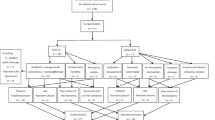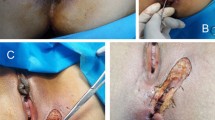Abstract
Purpose
Long-standing fistulizing and stenotic proctitis (LFSP) in Crohn’s disease (CD) indicates the end stage of the disease. Definitive diversion such as proctectomy is considered to be the only surgical option. The impact of intersphincteric sphincter-sparing anterior rectal resection (IAR) as an alternative to proctectomy is unclear. The aim of this study was to evaluate feasibility, morbidity, outcome, and quality of life (QL) in patients with LFSP undergoing intended IAR.
Patients and methods
Out of a single institution database, 15 patients with LFSP intended for surgery from 856 patients with CD were selected for follow-up analyses.
Results
In 12/15 cases, IAR was carried out while 3/15 patients underwent primary proctectomy due to malignancy (n = 2) or due to patient’s wish (n = 1). In one case, IAR revealed unexpected malignancy, which led to secondary proctectomy. In patients with IAR, complete healing of fistulas and stenosis was observed in 46 % (n = 5) while 36 % (n = 4) of patients showed relapse of fistula and 18 % (n = 2) developed restenosis. Ileostomy closure was performed in seven patients from which six patients remained stoma free. QL and fecal incontinence measured by standardized scoring systems were unchanged while stool frequency was reduced after IAR in patients with ileostomy closure. The rate of malignancy in this cohort was 20 % (n = 3).
Conclusion
LFSP in CD was associated with 20 % of malignant transformation. Although IAR fails to improve QL, it is a suitable procedure for the treatment of fistulas and stenosis associated with acceptable healing rates and can avoid a permanent stoma.


Similar content being viewed by others
References
American Gastroenterological Association Clinicial Practice Committee (2003) American Gastroenterological Association medical position statement: perianal Crohn’s disease. Gastroenterology 125(5):1503–1507
Galandiuk S, Kimberling J, Al-Mishlab TG, Stromberg AJ (2005) Perianal Crohn disease: predictors of need for permanent diversion. Ann Surg 241(5):796–801, discussion 801-792
Schwartz DA, Pemberton JH, Sandborn WJ (2001) Diagnosis and treatment of perianal fistulas in Crohn disease. Ann Intern Med 135(10):906–918
Ardizzone S, Porro GB (2007) Perianal Crohn’s disease: overview. Dig Liver Dis 39(10):957–958
de Zoeten EF, Pasternak BA, Mattei P, Kramer RE, Kader HA (2013) Diagnosis and treatment of perianal Crohn disease: NASPGHAN clinical report and consensus statement. J Pediatr Gastroenterol Nutr 57(3):401–412. doi:10.1097/MPG.0b013e3182a025ee
van Dongen LM, Lubbers EJ (1986) Perianal fistulas in patients with Crohn’s disease. Arch Surg 121(10):1187–1190
Fry RD, Shemesh EI, Kodner IJ, Timmcke A (1989) Techniques and results in the management of anal and perianal Crohn’s disease. Surg Gynecol Obstet 168(1):42–48
Buchmann P, Keighley MR, Allan RN, Thompson H, Alexander-Williams J (1980) Natural history of perianal Crohn’s disease. Ten year follow-up: a plea for conservatism. Am J Surg 140(5):642–644
Bell SJ, Williams AB, Wiesel P, Wilkinson K, Cohen RC, Kamm MA (2003) The clinical course of fistulating Crohn’s disease. Aliment Pharmacol Ther 17(9):1145–1151
Loffler T, Welsch T, Muhl S, Hinz U, Schmidt J, Kienle P (2009) Long-term success rate after surgical treatment of anorectal and rectovaginal fistulas in Crohn’s disease. Int J Color Dis 24(5):521–526
Tozer PJ, Burling D, Gupta A, Phillips RK, Hart AL (2010) Review article: medical, surgical and radiological management of perianal Crohn’s fistulas. Aliment Pharmacol Ther 33(1):5–22
Mueller MH, Geis M, Glatzle J, Kasparek M, Meile T, Jehle EC, Kreis ME, Zittel TT (2007) Risk of fecal diversion in complicated perianal Crohn’s disease. J Gastrointest Surg 11(4):529–537
Thomas M, Bienkowski R, Vandermeer T, Trostle D, Cagir B (2010) Malignant Transformation in Perianal Fistulas of Crohn’s Disease: a Systematic Review of Literature. J Gastrointest Surg 14(1):66–73
Melton GB, Fazio VW, Kiran RP, He J, Lavery IC, Shen B, Achkar JP, Church JM, Remzi FH (2008) Long-term outcomes with ileal pouch-anal anastomosis and Crohn’s disease: pouch retention and implications of delayed diagnosis. Ann Surg 248(4):608–616
Heuman R, Boeryd B, Bolin T, Sjodahl R (1983) The influence of disease at the margin of resection on the outcome of Crohn’s disease. Br J Surg 70(9):519–521
Hoffmann JC, Preiss JC, Autschbach F, Buhr HJ, Hauser W, Herrlinger K, Hohne W, Koletzko S, Krieglstein CF, Kruis W, Matthes H, Moser G, Reinshagen M, Rogler G, Schreiber S, Schreyer AG, Sido B, Siegmund B, Stallmach A, Bokemeyer B, Stange EF, Zeitz M (2008) Clinical practice guideline on diagnosis and treatment of Crohn’s disease. Z Gastroenterol 46(9):1094–1146
Dignass A, Van Assche G, Lindsay JO, Lemann M, Soderholm J, Colombel JF, Danese S, D’Hoore A, Gassull M, Gomollon F, Hommes DW, Michetti P, O’Morain C, Oresland T, Windsor A, Stange EF, Travis SP (2010) The second European evidence-based Consensus on the diagnosis and management of Crohn’s disease: Current management. J Crohn’s Colitis 4(1):28–62. doi:10.1016/j.crohns.2009.12.002
Jorge JM, Wexner SD (1993) Etiology and management of fecal incontinence. Dis Colon Rectum 36(1):77–97
Rabin R, de Charro F (2001) EQ-5D: a measure of health status from the EuroQol Group. Ann Med 33(5):337–343
Rockwood TH, Church JM, Fleshman JW, Kane RL, Mavrantonis C, Thorson AG, Wexner SD, Bliss D, Lowry AC (2000) Fecal Incontinence Quality of Life Scale: quality of life instrument for patients with fecal incontinence. Dis Colon Rectum 43(1):9–16, discussion 16-17
Guillem JG, Roberts PL, Murray JJ, Coller JA, Veidenheimer MC, Schoetz DJ Jr (1992) Factors predictive of persistent or recurrent Crohn’s disease in excluded rectal segments. Dis Colon Rectum 35(8):768–772
Andersson P, Olaison G, Bodemar G, Nystrom PO, Sjodahl R (2002) Surgery for Crohn colitis over a twenty-eight-year period: fewer stomas and the replacement of total colectomy by segmental resection. Scand J Gastroenterol 37(1):68–73
Kasparek MS, Glatzle J, Temeltcheva T, Mueller MH, Koenigsrainer A, Kreis ME (2007) Long-term quality of life in patients with Crohn’s disease and perianal fistulas: influence of fecal diversion. Dis Colon Rectum 50(12):2067–2074
Emmertsen KJ, Laurberg S (2012) Low anterior resection syndrome score: development and validation of a symptom-based scoring system for bowel dysfunction after low anterior resection for rectal cancer. Ann Surg 255(5):922–928. doi:10.1097/SLA.0b013e31824f1c21
Yamamoto T, Allan RN, Keighley MR (2000) Effect of fecal diversion alone on perianal Crohn’s disease. World J Surg 24(10):1258–1262, discussion 1262-1253
Hong MK, Craig Lynch A, Bell S, Woods RJ, Keck JO, Johnston MJ, Heriot AG (2011) Faecal diversion in the management of perianal Crohn’s disease. Color Dis 13(2):171–176
Iesalnieks I, Gaertner WB, Glass H, Strauch U, Hipp M, Agha A, Schlitt HJ (2010) Fistula-associated anal adenocarcinoma in Crohn’s disease. Inflamm Bowel Dis 16(10):1643–1648
Smith R, Hicks D, Tomljanovich PI, Lele SB, Rajput A, Dunn KB (2008) Adenocarcinoma arising from chronic perianal Crohn’s disease: case report and review of the literature. Am Surg 74(1):59–61
Sjodahl RI, Myrelid P, Soderholm JD (2003) Anal and rectal cancer in Crohn’s disease. Color Dis 5(5):490–495
Korelitz BI (1999) Carcinoma arising in Crohn’s disease fistulae: another concern warranting another type of surveillance. Am J Gastroenterol 94(9):2337–2339
Greenstein AJ, Sachar DB, Smith H, Janowitz HD, Aufses AH Jr (1981) A comparison of cancer risk in Crohn’s disease and ulcerative colitis. Cancer 48(12):2742–2745
Canavan C, Abrams KR, Mayberry J (2006) Meta-analysis: colorectal and small bowel cancer risk in patients with Crohn’s disease. Aliment Pharmacol Ther 23(8):1097–1104
Gyde SN, Prior P, Macartney JC, Thompson H, Waterhouse JA, Allan RN (1980) Malignancy in Crohn’s disease. Gut 21(12):1024–1029
Conflicts of interest
None of the authors has conflicts of interest to declare.
Funding
No funding was received for this study from any organization.
Author information
Authors and Affiliations
Corresponding author
Additional information
Nicolas Schlegel and Mia Kim contributed equally to this work.
Rights and permissions
About this article
Cite this article
Schlegel, N., Kim, M., Reibetanz, J. et al. Sphincter-sparing intersphincteric rectal resection as an alternative to proctectomy in long-standing fistulizing and stenotic Crohn’s proctitis?. Int J Colorectal Dis 30, 655–663 (2015). https://doi.org/10.1007/s00384-015-2201-2
Accepted:
Published:
Issue Date:
DOI: https://doi.org/10.1007/s00384-015-2201-2




